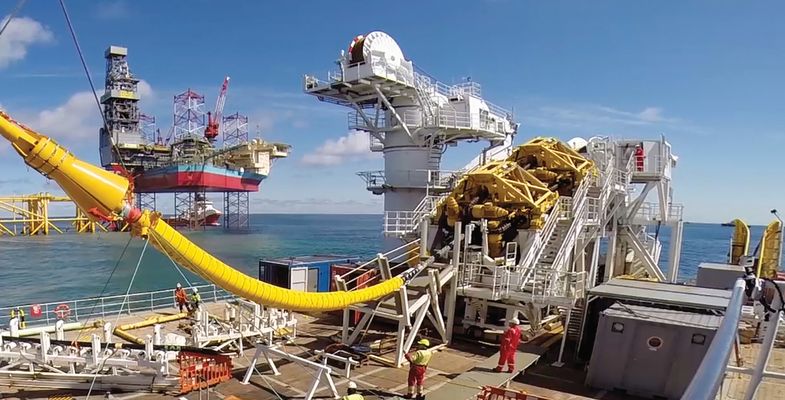IEEE 404 Subsea Cable Joint Testing
The IEEE 404 standard specifies requirements for the design, construction, and testing of subsea cable joints intended to be used in offshore energy applications. These cables are critical infrastructure that connects onshore facilities with distant offshore platforms, ensuring reliable power transmission across vast oceanic distances.
Offshore platforms and subsea cables operate under harsh environmental conditions, making their reliability paramount. The IEEE 404 standard ensures that joints can withstand the rigors of marine environments while maintaining electrical continuity and insulation integrity. This is achieved through rigorous testing protocols aimed at simulating real-world operating conditions as closely as possible.
The testing process involves several key steps: initial visual inspection, conductivity checks, dielectric strength testing, water ingress resistance tests, and mechanical stress assessments. Each of these stages ensures that the joint can perform its intended function without compromising safety or performance over time.
Visual inspections are conducted to ensure there is no visible damage or defects before proceeding with more detailed electrical and mechanical evaluations. Conductivity checks measure the joint's ability to conduct electricity efficiently, crucial for maintaining consistent power flow between platforms. Dielectric strength tests assess the joint’s resistance against high voltage, ensuring it can operate safely in potentially dangerous conditions.
Water ingress resistance tests simulate exposure to seawater, assessing whether moisture intrusion compromises the joint’s insulation properties. Mechanical stress assessments evaluate how well the joint withstands physical forces such as tension and bending, which are common challenges faced by subsea infrastructure. By adhering strictly to IEEE 404 standards during these tests, laboratories ensure compliance with international best practices.
Compliance with IEEE 404 is essential for quality managers and compliance officers responsible for ensuring that all components used in offshore energy projects meet industry benchmarks. R&D engineers benefit from this testing as it allows them to refine designs based on empirical data derived directly from rigorous tests conducted under controlled laboratory environments. Procurement teams also find value in these tests since they provide assurance regarding the reliability of suppliers' products.
Real-world applications highlight why adherence to IEEE 404 standards is crucial. For instance, improper joint design or manufacturing could lead to failures that disrupt operations and pose significant risks to personnel and equipment alike. By following this standard meticulously during testing phases, stakeholders mitigate these potential hazards effectively.
- Why Choose This Test: Conducted according to internationally recognized standards ensuring highest quality assurance.
- Benchmark Compliance: Meets rigorous requirements set forth by IEEE 404 for subsea cable joint integrity.
In conclusion, IEEE 404 subsea cable joint testing represents an essential step towards guaranteeing the robustness and longevity of offshore energy infrastructure. Through meticulous adherence to established protocols, laboratories contribute significantly to enhancing safety standards within this critical sector.
Benefits
The IEEE 404 subsea cable joint testing offers numerous advantages for stakeholders involved in offshore energy projects:
- Enhanced Reliability: Ensures that all subsea cables and their joints meet the highest safety standards, reducing the risk of failures.
- Improved Efficiency: By conducting thorough tests before deployment, potential issues are identified early on, saving time and resources in the long run.
- Increased Safety: Rigorous testing helps prevent accidents caused by defective joints or substandard materials, protecting personnel and assets alike.
- Sustained Performance: Through continuous monitoring and maintenance advised based on test results, performance degradation can be minimized over time.
- Regulatory Compliance: Adherence to IEEE 404 ensures that all components comply with relevant regulations, facilitating smoother project approvals.
- Cost Savings: Early detection of problems leads to lower maintenance costs and extended asset lifespans.
In summary, implementing IEEE 404 subsea cable joint testing not only enhances the overall quality but also contributes significantly towards achieving long-term cost savings and operational efficiency in offshore energy operations.
Why Choose This Test
Selecting IEEE 404 subsea cable joint testing for your project is a strategic decision that underscores commitment to excellence. Here are several compelling reasons why this particular test stands out:
- International Recognition: The IEEE standard is widely accepted globally, providing credibility and assurance to all involved parties.
- In-depth Assessment: Comprehensive evaluation of both electrical and mechanical properties ensures comprehensive coverage of potential issues.
- Precision Engineering: Tailored tests cater specifically to the unique requirements of subsea cables used in offshore energy applications, ensuring accuracy and reliability.
- Expertise and Experience: Our team comprises seasoned professionals with extensive experience in performing such specialized tests, ensuring precision and consistency.
- Timely Results: Efficient testing processes mean quicker turnaround times for reports, enabling faster decision-making.
- Cost-effective Solutions: By identifying defects early on, unnecessary expenses associated with delayed projects or rework are minimized.
In choosing IEEE 404 subsea cable joint testing, you demonstrate a commitment to quality and reliability, setting the foundation for successful offshore energy ventures.
Environmental and Sustainability Contributions
The IEEE 404 subsea cable joint testing plays a crucial role in promoting environmental sustainability within the offshore energy sector. By ensuring that all components used adhere strictly to international standards, this testing contributes significantly towards minimizing waste generation throughout the entire lifecycle of an installation.
- Reduced Environmental Impact: Ensuring reliable performance through thorough testing helps prevent failures leading to spills or leaks into aquatic ecosystems.
- Energy Conservation: Reliable subsea cable joints contribute to efficient power transmission, reducing energy losses during transport and distribution.
- Extended Lifespan: By identifying potential issues early on, maintenance intervals can be optimized, extending the useful life of installations without unnecessary replacements.
- Resource Efficiency: Minimized downtime translates into greater operational efficiency, conserving resources both in terms of manpower and material usage.
Incorporating IEEE 404 subsea cable joint testing into your project planning process not only enhances safety standards but also supports broader sustainability goals within the industry. It promotes responsible resource management practices that align with global environmental initiatives aimed at reducing carbon footprints and fostering greener energy solutions.





